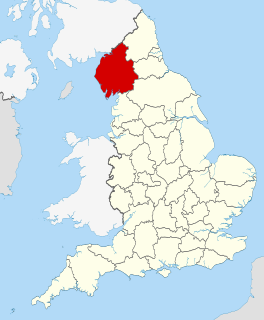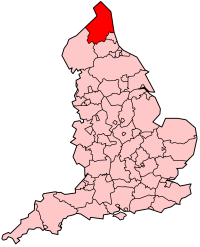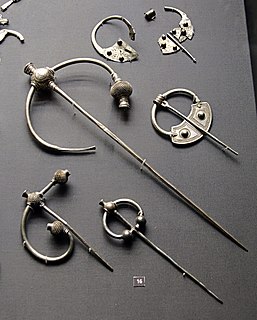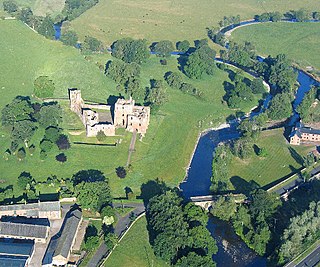
Cumbria is a ceremonial and non-metropolitan county in North West England. The county and Cumbria County Council, its local government, came into existence in 1974 after the passage of the Local Government Act 1972. Cumbria's county town is Carlisle, in the north of the county, and the only other major urban area is Barrow-in-Furness on the southwestern tip of the county.
Abandinus was a name used to refer to a Celtic god or male spirit worshipped in Godmanchester in Cambridgeshire during the Romano-Celtic period.
Belatucadros or Belatucadrus, was a deity worshipped in Celtic northern Britain, particularly in Cumberland and Westmorland. In the Roman period he was identified with Mars and appears to have been worshipped by lower-ranked Roman soldiers as well as by Britons. In five inscriptions he is called Mars Belatucadrus. The name is frequently translated as ‘fair shining one’ or ‘fair slayer’.
In Romano-British religion, Cocidius was a deity worshipped in northern Britain. The Romans equated him with Mars, god of war and hunting, and also with Silvanus, god of forests, groves and wild fields. Like Belatucadros, he was probably worshipped by lower-ranked Roman soldiers as well as by the Britons for whom he was probably a tribal god - a genius loci.
In Romano-British culture and Germanic polytheism, the Alaisiagae were a pair of Celtic and Germanic goddesses deifying victory.

The Carvetii were an Iron Age people and were subsequently identified as a civitas (canton) of Roman Britain living in what is now Cumbria, in North-West England.

Eboracum was a fort and later a city in the Roman province of Britannia. In its prime it was the largest town in northern Britain and a provincial capital. The site remained occupied after the decline of the Roman Empire and ultimately evolved into the present-day city York, occupying the same site in North Yorkshire, England.

Northumberland, England's northernmost county, is a land where Roman occupiers once guarded a walled frontier, Anglian invaders fought with Celtic natives, and Norman lords built castles to suppress rebellion and defend a contested border with Scotland. The present-day county is a vestige of an independent kingdom that once stretched from Edinburgh to the Humber, hence its name, meaning literally 'north of the Humber'. Reflecting its tumultuous past, Northumberland has more castles than any other county, and the greatest number of recognised battle sites. Once an economically important region that supplied much of the coal that powered the industrial revolution, Northumberland is now a primarily rural county with a small and gradually shrinking population.

In Romano-British worship, the local god Antenociticus, also recorded as "Anociticus" at the same temple site in Benwell, was possibly worshipped as source of inspiration and intercession in military affairs.
Veteris was a Celtic god attested from many inscriptions in Roman Britain. The dedicants were usually private individuals and were exclusively male. During the 3rd Century AD the cult was particularly popular among the ranks of the Roman army.
Tridamos is the male deification of supposed bovine triplication in ancient Celtic polytheism, conceived as a manifestation of abundance.
Mogons or Moguns was a Celtic god worshiped in Roman Britain and Gaul. The main evidence is from altars dedicated to the god by Roman soldiers.
Matunus or Matunos was a god in Brythonic Celtic polytheism. His name may be derived from the same root as Proto-Celtic *matu- meaning bear. He was worshipped in Roman Britain and altar-stones raised to him have been recovered in the United Kingdom, such as at High Rochester and at Risingham.
In ancient Celtic polytheism, Latis is the name of two Celtic deities worshipped in Roman Britain. One is a goddess, the other a god, and they are both known from a single inscription each.
Toutatis or Teutates is a Celtic god who was worshipped in ancient Gaul and Britain. On the basis of his name's etymology, he has been widely interpreted to be a tribal protector.

Joshua Alder was a British cheesemonger and amateur zoologist and malacologist. As such, he specialized in the Tunicata, and in gastropods.

Clifton & Lowther railway station was a station on the Lancaster and Carlisle Railway (L&CR) south of Penrith near to the village of Clifton. Although it was the original terminus to cross Pennines rail traffic on the Eden Valley Railway, it was rapidly by-passed by a new line and junction. The station, which was on the West Coast Main Line, was treated as a private stop by the Earls of Lonsdale.

The Penrith Hoard is a dispersed hoard of 10th century silver penannular brooches found at Flusco Pike, Newbiggin Moor, Near Penrith in Cumbria, and now in the British Museum in London. The largest "thistle brooch" was discovered in 1785 and another in 1830, with the bulk of items being recovered in two groups close to each other by archaeologists in 1989. Whether all the finds made close to each other were originally deposited at the same time remains uncertain, but it is thought likely that at least the brooches were. The brooches are thought to have been deposited in about 930.

Celtic mythology is the mythology of Celtic polytheism, the religion of the Iron Age Celts. Like other Iron Age Europeans, the early Celts maintained a polytheistic mythology and religious structure. For Celts in close contact with Ancient Rome, such as the Gauls and Celtiberians, their mythology did not survive the Roman Empire, their subsequent conversion to Christianity and the loss of their Celtic languages. It is mostly through contemporary Roman and Christian sources that their mythology has been preserved. The Celtic peoples who maintained either political or linguistic identities left vestigial remnants of their ancestral mythologies that were put into written form during the Middle Ages.

Brocavum is the Latin name of a Roman fort at Brougham near Penrith, Cumbria. The fort survives as earthworks, but no excavation of these has been carried out so far.















